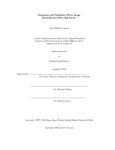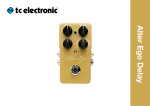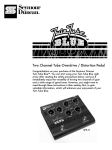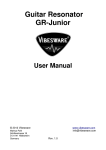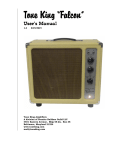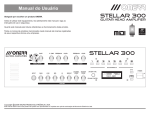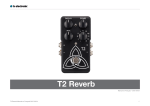Download TC electronic SDN BHD NDY-1 User's Manual
Transcript
NDY -1 NOVA Dynamics USER’S MANUAL TABLE OF CONTENTS INTRODUCTION ADDITIONAL FEATURES Table of Contents . . . . . . . . . . . . . . . . . . . . . . . . . . . .3 Introduction . . . . . . . . . . . . . . . . . . . . . . . . . . . . . . . .4 Calibration . . . . . . . . . . . . . . . . . . . . . . . . . . . . . . . .17 APPENDIX SETUP EXAMPLES Technical Specifications . . . . . . . . . . . . . . . . . . . . . .18 Mono + Dual Processing . . . . . . . . . . . . . . . . . . . . . .5 Single Input – Dual Output . . . . . . . . . . . . . . . . . . . . .6 Pre and Post Processing . . . . . . . . . . . . . . . . . . . . . .7 Dual Inputs – Single Output . . . . . . . . . . . . . . . . . . . .8 OPERATION Overview . . . . . . . . . . . . . . . . . . . . . . . . . . . . . . . . . .9 Connections . . . . . . . . . . . . . . . . . . . . . . . . . . . . . . .10 Switches . . . . . . . . . . . . . . . . . . . . . . . . . . . . . . . . . .10 Compression Basics . . . . . . . . . . . . . . . . . . . . . . . . .11 Compression Parameters . . . . . . . . . . . . . . . . . . . . .11 Suggested Settings – Compressor . . . . . . . . . . . . .14 Noise Gate Basics . . . . . . . . . . . . . . . . . . . . . . . . . .15 Noise Gate Parameters . . . . . . . . . . . . . . . . . . . . . .15 Suggested Settings – Noise Gate . . . . . . . . . . . . . .16 TC Electronic, Sindalsvej 34, DK-8240 Risskov – [email protected] English Version Manual revision 1.1 – SW – V 1.0 Prod. No: E60508511 3 INTRODUCTION NOVA Dynamics – Contents Under Pressure A high quality dual engine compression and noise gate stomp box, packed with never before seen functionalities: NOVA Dynamics sets new standards for floor-based dynamics control. Its dual engine design offers a variety of setup and control options that allow you to tailor NOVA Dynamics to fit your rig. Use the two engines for different compression settings or switch between stomp compression for that classic “squash” and TC’s advanced multiband compression for subtle, studio-style dynamics control. You can even split the NOVA Dynamics’ two engines, allowing you to use a compressor in front of your amp and a noise gate in your amp’s effects loop for true noise reduction of high gain signals. The Dry Blend feature lets you blend your dry signal in with the compressed signal. This gives you an optimized attack without eating into the dynamics. At the same time, the automatic input gain adjustment on both engines provides perfect settings for e.g. both a Strat and a Les Paul at the flick of a switch. Brings control to any guitar rig NOVA Dynamics Features • 2 Compressor Modes: Studio and Stomp • Noise Gate • Dual Engine Design • Dry Blend – Parallel Compression • Flexible Routing • Auto Input Gain Adjustment • Precise Gain Reduction Meter 4 SETUP EXAMPLE: MONO + DUAL PROCESSING In this setup, the two engines can be used individually or serially. You can use two compressors, two noise gates, or one of each at the same time. • • • • Connect your guitar to input A of the NOVA Dynamics. Connect output A of the NOVA Dynamics to the input of your guitar amp. Activate engine A and/or B and select the desired compression type and/or noise gate algorithm. That’s all! Note: For best signal to noise ratio, calibrate the pedal according to the level of the input signal. For further information, refer to this manual’s “Calibration” section. 5 SETUP EXAMPLE: SINGLE INPUT – DUAL OUTPUT In this setup, the guitar signal on input A is fed to both engines A and B. This means that the two channels are processed 100 % separately. Please note that this is not a stereo setup. • • • Connect your guitar to input A of the NOVA Dynamics. Connect output A of the NOVA Dynamics to the input of one amp. Connect output B to the input of another amp. You can now use the two engines like two completely separate pedals for processing your guitar’s sound. Note: For best signal to noise ratio, calibrate the pedal according to the level of the input signal. For further information, refer to this manual’s “Calibration” section. 6 SETUP EXAMPLE: PRE & POST PROCESSING In this example, we are using the two engines of NOVA Dynamics in two different places in a signal chain. One engine is used in front of the pre-amp for compression, while the other is being used in the effects-loop as a noise gate. • • • • Connect your guitar to input A of the NOVA Dynamics. Connect output A of the NOVA Dynamics to the amp’s regular input. Connect the “Send” jack of the effect loop to input B of the NOVA Dynamics. Connect output B of the NOVA Dynamics to the “Return” jack of the effects loop. Note: For best signal to noise ratio, calibrate the pedal according to the level of the input signal. You will love the fact that each engine of the NOVA Dynamics has its own individual level calibration. For further information, refer to this manual’s “Calibration” section. 7 SETUP EXAMPLE: DUAL INPUTS In this setup, we utilize the NOVA Dynamics’ auto-sensing inputs to connect two guitars at the same time. This allows for individual level calibration of the inputs, which is a great advantage if e.g. you want to use two guitars which have very different output levels due to different pick-up configurations. This might be the case if there are passive single coils on one guitar and active humbuckers on the other. Furthermore, you save an A/B switch in your setup. • • • Connect two guitars to the inputs A and B of the NOVA Dynamics. Connect output A of the NOVA Dynamics to the input of your amp. Be sure to turn down the volume potentiometer on the guitar not currently in use. Note: For best signal to noise ratio, calibrate your guitars individually. For further information, refer to this manual’s “Calibration” section. 8 OVERVIEW A output B thresh A input B level/damp attack ratio/rel GAIN RED -2 -4 -6 -8 -10 -12 -16 -20 -24 min med max A B dry blend A/B toggle studio stomp n.gate power thresh level/damp attack ratio/rel studio stomp n.gate HOLD to calib algorithm min med max HOLD to calib A algorithm dry blend B NDY1 NOVA DYNAMICS DUAL COMPRESSOR + NOISE GATE 9 OPERATION CONNECTIONS Switches 1 – Power The NOVA Dynamics requires 12V DC 300 mA. Use the power supply provided in the product box. 4 & 5 – On/Off Switches In “normal” mode (when the A/B button is turned off), these switches operate as standard on/off switches for engines A and B. In “A/B” mode (when the A/B button is lit), you can toggle between engine A and B simply by pressing either switch A or B. 2 – Input Jacks These are ¼" mono jack connectors for signal input. NOVA Dynamics operates as two independent pedals with various possible combinations. Two different guitars can be connected to inputs A and B. Always use input A if you connect only one guitar. When a guitar or other signal source is connected to input B, inputs A and B can be calibrated individually. 3 – Output Jacks These are ¼" mono jack connectors which carry the signals from channels A and B. 10 OPERATION Compression Basics A compressor is used to control the dynamic content of a signal. It can be used either for leveling out the signals dynamics (thus letting your guitar sound stand out clearer), or for immediately recognizable sustaining effects. Illustration - Signal Compression Compressor Parameters 6 – Threshold Range: -40 dB to 0 dB The THRESHOLD knob on the NOVA Dynamics pedal is equivalent to what is called “sustain” on many other pedals. Basically it sets the threshold level where the compressor kicks in. The lower the threshold, the less input level the compressor needs to start compressing and the more sustain you will get. Turn the THRESHOLD knob counter-clockwise for more compression (= lower threshold) and clockwise for less compression. 7 – Level Any degree of compression, and especially “heavy” compression, will cause a reduction in output volume. Use the LEVEL knob to compensate for this or to even boost the signal. 8 – Attack The Attack time is the response time of the Compressor. The shorter the Attack time, the sooner the Compressor will reach the amount of compression 11 OPERATION set by the Ratio parameter. Turn the ATTACK knob counter-clockwise for “squashing” the signal more and clockwise for a more subtle compression. 9 – Ratio This parameter determines how hard the signal is compressed – see the illustration on the previous page. Turn clockwise for more extreme compression. For more information, refer to this manual’s “Suggested Settings” section. The “Studio” compressor mode uses so-called multiband compression (in this case, three bands), that you would normally only find in expensive studio compressors. This 3-band compressor allows individual processing of low, mid and high-end frequencies. The advantage of this technique is that e.g. a loud, pumping bass figure is processed separately and therefore won’t influence the mid and high-end frequencies. 10 – Meter In Compressor Mode, the meter indicates the current attenuation (compression) of the signal while you are playing. In Noise Gate Mode, the meter indicates the amount of attenuation of the signal when the gate is active. “Stomp” (Compressor): The “Stomp” compressor mode gives you the kind of hard compression typically associated with stomp box compressors. Use this mode if you aim for an audible compression effect with either a “twang” or a “popping” sound. 11 + 14 – Algorithm Use these switches to select the algorithms for the two channels. The options are: Gate: In Gate Mode, the engine acts as a noise gate. Read more in the manual section: “Noise Gate”. Studio (Compressor): This is a subtle compression type. It ensures that your guitar is present with a constant level in the mix. 12 OPERATION 12 + 15 – Dry/Blend The Dry/Blend function allows you to use parallel compression. Basically, this means splitting the signal in two and compressing only one part of the signal. With the DRY BLEND switch, you can cycle through three predefined levels of blend and “off”. LED A flashing - the input level for input A is too hot. Recalibrate the pedal. Choose between Off: No blend Min: 75 % wet Med: 50 % wet Max: 25 % wet LED B flashing - the input level for input B is too hot. If you are using dual input mode (two instruments) recalibrate input B. If you are using Engines A+B in serial - reduce the output level of Engine A using the LEVEL knob. the following settings: and 25 % dry and 50 % dry and 75 % dry The Dry Blend function is especially useful for creating hard sustaining compression without sacrificing the natural attack. 16 – Clipping indicators If these LEDs flash you have a too hot signal somewhere in the signal processing. Both LEDs flashing - recalibrate and reduce the general level on both Engines A and B. 13 SUGGESTED SETTINGS This section is a short guide on how to achieve different kinds of compression and gating with NOVA Dynamics. In these examples, we will only look at a single engine. Start out by setting all controls at a 12 o’clock (center) position. This is always an excellent starting point. Notice that the calibration of the pedal and the general output of your pick-ups has a huge influence on where the Threshold knob should be positioned. Compressor – Suggested Settings All-round compression Set TYPE to “Studio” 14 Sustaining compression Set TYPE to “Stomp” Gentle Compression: E.g. for clean chords. Set TYPE to “Studio” Sustaining compression with natural attack Set Type to Stomp and experiment with the three Dry Blend options. Heavy Squash for Country & Funk: Set type to Stomp and set Dry Blend to off OPERATION Noise Gate Basics The NOVA Dynamics Noise Gate is used to attenuate the signal when you are not playing your guitar. This way, you can mute hissing, humming and other noise coming from cables, pedals etc. Of course, a noise gate can only cancel noises from equipment which is located before the gate in the signal path. Please note that a noise gate is not the ultimate solution to noise problems. You should always try to avoid noise in the first place! Noise can be introduced by a number of factors. Poor cables, poorly shielded single coil pickups and power supplies placed too close to signal cables are common problems that you can work around by experimenting. However, a certain amount of noise will always be present in any guitar setup. The NOVA Dynamics Noise Gate can help you attenuate this noise when you are not playing. Be careful, though, when setting the Threshold and Release parameters. A Threshold set too high may result in the Gate not opening when you play the guitar softly. A Release time set too slow, may result in the gate cutting into the attack phase of the signal. Furthermore it is worth noticing that the NOVA Dynamics Gate offers 4 modes of Noise Gate selectable via the DRY BLEND button. From full-range mode to three tuned 3-band Noise Gate modes. Illustration - Noise Gate Noise Gate Parameters 6 – Threshold The Threshold point determines at what point the Noise Gate should start dampening the signal. Start by setting the THRESHOLD knob to the “min” 15 OPERATION position (fully counter-clockwise) and set all other controls to “12 o’clock” (center) position. Now turn up your guitar’s volume potentiometer, but do not play. Then turn up the THRESHOLD knob to the point where the gate starts dampening you signal. 7 – Damp This parameter determines how hard the signal should be attenuated when the signal level falls below the set Threshold. Now you may think that you should always go for maximum dampening. However, bear in mind that you should also strive for a smooth transition from the “gated/attenuated” stage to the “open” stage. The more dBs that are released when the Gate opens, the more obvious the gating effect becomes. This means that you will have to experiment to fine-tune the Noise Gate to your sounds – there is no “one-size-fits-all” setting. 8 – Attack Attack is the time it takes for the Noise Gate to release the gain reduction of the signal after the level of the input signal has exceeded the Threshold. In other words: With Attack, you determine how fast the gate 16 should open when you are playing your guitar. For guitar setups it is very common to use very fast attack times. Turn ATTACk counter-clockwise for faster attack times. 9 – Release Release is the time it takes for the Noise Gate to reach the attenuation specified by the Damp parameter when the signal drops below the Threshold point. In other words: with Release, you determine how fast the gate should close when you stop playing. Slow release times are achieved by turning the knob clockwise and results in a very natural sounding fade out. A faster release time is achieved by turning the knob counterclockwise and is typically used for hard-rock and metal where the gate needs to close very fast. 12 – Dry Blend function in the Noise Gate Dry Blend mode off (no LEDs): Select this mode for a full-band Noise Gate. Dry Blend modes; Min, Mid & Max: These modes process low, mid and high frequencies OPERATION & SUGGESTED SETTINGS individually and allows more gentle gating compared to the full-band mode. This is achieved by letting certain frequency areas of the dry signal pass, even when the gate is active. Dry Blend is excellent for reducing/removing significant noise without sounding un-natural. Noise Gate with Dry Blend activated works great when the gate is used in an amp’s effects loop or after hi-gain distortion pedals. Noise Gate simple setup procedure: • Start out by setting all controls in 12 o’clock position • Turn up the guitars volume pot without playing • Now tweak the THRESHOLD knob until you find the exact point where the desired attenuation of the noise is achieved • Experiment with the three Dry Blend modes Note that “Min”, “Mid” and “Max” refers to Dry Blend and therefore “Min” mode provides the most attenuation, “Max” mode provides the least. Noise Gate – Suggested Settings 13 – A/B toggle When the A/B switch is off (not lit), you can switch off channels A and B as if you were using two separate pedals. When the A/B switch is on (LED green), you can toggle between channels A and B simply by pressing the A or B switch. To completely bypass the pedal, press the switch of the currently active channel. Gentle Noise Gate Dry Blend set to “max” Heavy Noise Gate 17 INPUT LEVEL CALIBRATION Your NOVA Dynamics pedal is per default set to work well right out of the box – just as any other “stomp box” pedal. However, you can optimize the performance of the NOVA Dynamics pedal’s AD/DA converters by calibrating the input sensitivity. Follow the step-by-step guide below for EACH of the engines** – especially if you are using one engine before the amp and one after the amp as described in the “Pre & Post” setup example on page 7. Automatic Calibration • Calibration of the input sensitivity should be set according to the expected maximum input level. Therefore, you should always start by turning on boosters and other signal-attenuating equipment that has been placed before the NOVA Dynamics pedal in the signal chain. • Press and hold the ALGORITHM button, for the engine you intend to calibrate**, until all Meter LEDs (-2 to -24) are lit. • Play with your loudest* sound for a few seconds. The nine LEDs will turn off one by one. How many LEDs are turned off depends on the output of your 18 • • guitar. When there seem to be no more changes, the pedal is calibrated. Press any key to exit. The pedal is now calibrated. * By “loudest”, we mean the sound with the highest dynamic content. This is most likely a clean sound, as by definition overdrive sounds are compressed – i.e. they have less dynamics. ** In single engine mode (nothing connected to input B), only Engine A can be calibrated. Manual Calibration If you prefer to change the input gain manually, you can. • Press and hold the ALGORITHM switch of the engine for which you intend to change the input gain. • All meter LEDs are lit briefly. After that, a single LED will stay lit to indicate the current gain setting. • Now turn the LEVEL knob and adjust the gain setting. • Press any key to exit. TECHNICAL SPECIFICATIONS Analog Inputs Connectors: Input Type Impedance: Max. Input Level: Analog Outputs Connectors: Max. Output Level: Output Type Impedance Sense Input Impedance Overall Data D to A Conversion A to A Delay Dynamic Range THD Frequency Response Crosstalk EMC Complies with: ¼" phone jacks w. mono-sense Single ended 1 MOhm 10 dBu @ 12V supply Environment Operating Temperature: Storage Temperature: Humidity: General Finish: ¼" phone jacks w. mono-sense 10 dBu @ 12V supply Balanced/Single ended w. ground sense 0 Ohm 225 Ohm 24 bit, 128 x oversampling bitstream 1.65 ms 106/98 dB, 20 Hz to 20 KHz @ Input level 16/-2 dBu, not A-weighted < -90 dB (0.0032 %) @ 1 kHz, I/O Level 16 dBu, Load > 2400 Ohm +0.1/-0.2 dB, 20 Hz to 20 KHz < -100 dB, 20 Hz to 7 KHz, < -94 dB, 7 kHz to 20 kHz EN 55103-1 and EN 55103-2 FCC Part 15, Class B, CISPR 22, Class B 32° F to 122° F (0° C to 50° C) -22° F to 167° F (-30° C to 70° C) Max. 90 % non-condensing Power Consumption Anodized aluminum front Plated and painted steel end caps 130 x 130 x 55 mm 765 g 100 to 240 VAC, 50 to 60 Hz (auto-select) AC wall adapter. AC adapter supplies 12 VDC minimum 0.3 A to pedal. <5 W Warranty Parts and labor 1 year Dimensions: Weight: Mains Voltage Due to continuous development, these specifications are subject to change without notice. 19





















